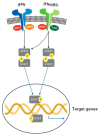New Insights into Immunotherapy Strategies for Treating Autoimmune Diabetes
- PMID: 31561568
- PMCID: PMC6801436
- DOI: 10.3390/ijms20194789
New Insights into Immunotherapy Strategies for Treating Autoimmune Diabetes
Abstract
Type 1 diabetes mellitus (T1D) is an autoimmune illness that affects millions of patients worldwide. The main characteristic of this disease is the destruction of pancreatic insulin-producing beta cells that occurs due to the aberrant activation of different immune effector cells. Currently, T1D is treated by lifelong administration of novel versions of insulin that have been developed recently; however, new approaches that could address the underlying mechanisms responsible for beta cell destruction have been extensively investigated. The strategies based on immunotherapies have recently been incorporated into a panel of existing treatments for T1D, in order to block T-cell responses against beta cell antigens that are very common during the onset and development of T1D. However, a complete preservation of beta cell mass as well as insulin independency is still elusive. As a result, there is no existing T1D targeted immunotherapy able to replace standard insulin administration. Presently, a number of novel therapy strategies are pursuing the goals of beta cell protection and normoglycemia. In the present review we explore the current state of immunotherapy in T1D by highlighting the most important studies in this field, and envision novel strategies that could be used to treat T1D in the future.
Keywords: autoimmunity; diabetes; immunotherapy and clinical trials; insulin.
Conflict of interest statement
P.S. and E.H. are employees and shareholders of Incyte Corporation. M.C.-O., M.A., I.R. and M.B. have no conflict of interest.
Figures
References
-
- Barrett J.C., Clayton D.G., Concannon P., Akolkar B., Cooper J.D., Erlich H.A., Julier C., Morahan G., Nerup J., Nierras C., et al. Genome-wide association study and meta-analysis find that over 40 loci affect risk of type 1 diabetes. Nat. Genet. 2009;41:703–707. doi: 10.1038/ng.381. - DOI - PMC - PubMed
Publication types
MeSH terms
Substances
LinkOut - more resources
Full Text Sources
Medical
Research Materials



